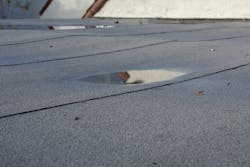An often cited 2020 report from the U.S. Government Accounting Office stated that about 36,000 schools in the United States needed updates to their heating, ventilation and air-conditioning systems. But HVAC systems were not the only element of school infrastructure found to be lacking.
The data collected for the report also indicated that about 28,000 schools (a conservative estimate, the GAO says) needed to update or replace their roofing. The size of the problem is not surprising. School systems have for decades been plagued by the problem of deferred maintenance. Without adequate resources to keep their facilities in good condition, many schools put off repairs less urgent, or in some cases, less visible facility deficiencies—like a leaky roof.
The GAO report highlighted the example of a school in Florida that found the money to update its campus with new cameras and other security upgrades while deploying multiple buckets throughout the school to collect the water that routinely leaked through the roof into the facility.
An inadequately maintained roof with unaddressed damage or deterioration can lead to leaks that seep into the building and cause unseen but ultimately costly damage to buildings. Those leaks also create conditions for the growth of mold and other air quality problems that may be silently undermining the health of students and staff.
A lot can happen atop a roof over time, and without regular inspections, undetected minor problems can become major headaches. Sun, snow, freezing and melting water can cause a roof to age prematurely. Trees, leaves and other vegetation that are not removed expeditiously can damage the surface. Lightning and high winds also can be destructive. In some cases, equipment is installed on a roof without proper flashing or weatherproofing, or non-roofing workers may cause punctures or spills on the surface as they attend to other chores.
A school’s first line of defense for roof maintenance is conducting inspections; most organizations recommend inspections twice a year. Regular inspections enable schools and universities to discover deterioration or damage early on before problems have time to seep inside the building and cause major facility problems.
"Roofs should be included in a preventive maintenance program and inspected on a regular schedule," says the U.S. Departmentof Educaton's Planning Guide for Maintaining School Facilities. "The key to maintaining good roofs is the timely removal of water from the surface and substructure of the roof."
Autumn is considered a good time for one of those inspections. Before winter weather makes it more difficult to safely gain access to roofs, maintenance staff can check for any visible problems and address any issues that could become worse over the winter.
Some of the conditions to address:
- Clean debris or unwanted growth that is preventing water from draining off roof surfaces.
- Clean drains, gutters, and downspouts.
- Check walls and ceilings for signs of water and staining.
- Inspect surfaces for signs of wear, such as bubbling, blistering, punctures, torn or cracked seams, bare spots or pooling water.
- Inspect roof flashing to make sure there are no gaps or holes. Make sure the caulking around flashing is not cracked or missing.
- Check HVAC systems, ducts, skylights and other equipment on a roof for any signs of deterioration that could result in leaks.
- Check for signs of an infestation of birds, rodents or insects.
When problems are detected, schools should take immediate action to repair leaks and damage. Even if no repairs are necessary, schools should document conditions observed during their inspections to monitor conditions that may raise concerns.
In some cases, inspectors may suspect that moisture has worked its way inside a building, even there is no evidence of a leak or damage to the surface. An infrared device can be used to detect if moisture is present inside a facility without puncturing or otherwise damaging the roof surface.
The State Office of Risk Management in Texas recommends that roofs also should be inspected before and after storms "to decrease the impact of flying projectiles, blocked drains or to protect valuable machinery."
To minimize potential damage to roofs, schools should restrict access to their roofs to only necessary personnel. Inspectors or other workers who are allowed on the roof should walk in areas that will minimize damage to the roof membrane. Some buildings have designated roof walkways to steer people away from potential trouble spots.
About the Author
Mike Kennedy
Senior Editor
Mike Kennedy, senior editor, has written for AS&U on a wide range of educational issues since 1999.
